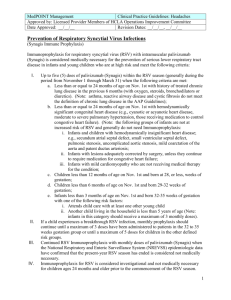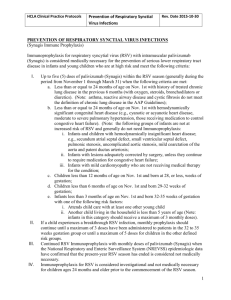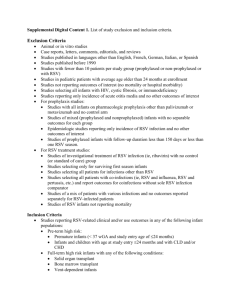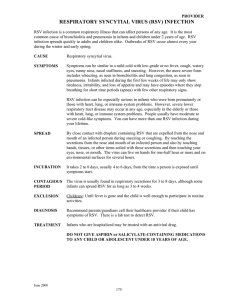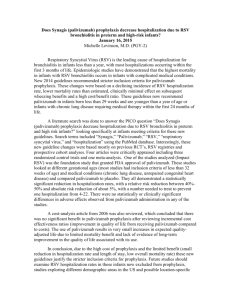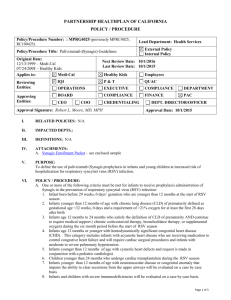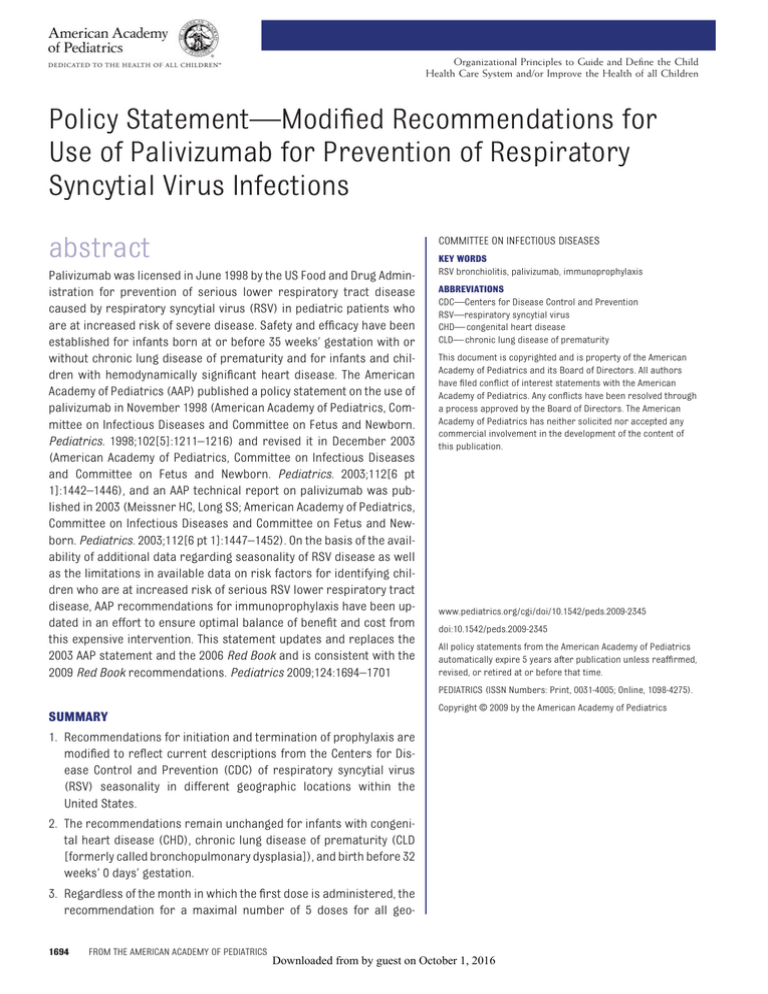
Organizational Principles to Guide and Define the Child
Health Care System and/or Improve the Health of all Children
Policy Statement—Modified Recommendations for
Use of Palivizumab for Prevention of Respiratory
Syncytial Virus Infections
COMMITTEE ON INFECTIOUS DISEASES
abstract
Palivizumab was licensed in June 1998 by the US Food and Drug Administration for prevention of serious lower respiratory tract disease
caused by respiratory syncytial virus (RSV) in pediatric patients who
are at increased risk of severe disease. Safety and efficacy have been
established for infants born at or before 35 weeks’ gestation with or
without chronic lung disease of prematurity and for infants and children with hemodynamically significant heart disease. The American
Academy of Pediatrics (AAP) published a policy statement on the use of
palivizumab in November 1998 (American Academy of Pediatrics, Committee on Infectious Diseases and Committee on Fetus and Newborn.
Pediatrics. 1998;102[5]:1211–1216) and revised it in December 2003
(American Academy of Pediatrics, Committee on Infectious Diseases
and Committee on Fetus and Newborn. Pediatrics. 2003;112[6 pt
1]:1442–1446), and an AAP technical report on palivizumab was published in 2003 (Meissner HC, Long SS; American Academy of Pediatrics,
Committee on Infectious Diseases and Committee on Fetus and Newborn. Pediatrics. 2003;112[6 pt 1]:1447–1452). On the basis of the availability of additional data regarding seasonality of RSV disease as well
as the limitations in available data on risk factors for identifying children who are at increased risk of serious RSV lower respiratory tract
disease, AAP recommendations for immunoprophylaxis have been updated in an effort to ensure optimal balance of benefit and cost from
this expensive intervention. This statement updates and replaces the
2003 AAP statement and the 2006 Red Book and is consistent with the
2009 Red Book recommendations. Pediatrics 2009;124:1694–1701
KEY WORDS
RSV bronchiolitis, palivizumab, immunoprophylaxis
ABBREVIATIONS
CDC—Centers for Disease Control and Prevention
RSV—respiratory syncytial virus
CHD— congenital heart disease
CLD— chronic lung disease of prematurity
This document is copyrighted and is property of the American
Academy of Pediatrics and its Board of Directors. All authors
have filed conflict of interest statements with the American
Academy of Pediatrics. Any conflicts have been resolved through
a process approved by the Board of Directors. The American
Academy of Pediatrics has neither solicited nor accepted any
commercial involvement in the development of the content of
this publication.
www.pediatrics.org/cgi/doi/10.1542/peds.2009-2345
doi:10.1542/peds.2009-2345
All policy statements from the American Academy of Pediatrics
automatically expire 5 years after publication unless reaffirmed,
revised, or retired at or before that time.
PEDIATRICS (ISSN Numbers: Print, 0031-4005; Online, 1098-4275).
SUMMARY
1. Recommendations for initiation and termination of prophylaxis are
modified to reflect current descriptions from the Centers for Disease Control and Prevention (CDC) of respiratory syncytial virus
(RSV) seasonality in different geographic locations within the
United States.
2. The recommendations remain unchanged for infants with congenital heart disease (CHD), chronic lung disease of prematurity (CLD
[formerly called bronchopulmonary dysplasia]), and birth before 32
weeks’ 0 days’ gestation.
3. Regardless of the month in which the first dose is administered, the
recommendation for a maximal number of 5 doses for all geo1694
FROM THE AMERICAN ACADEMY OF PEDIATRICS
Copyright © 2009 by the American Academy of Pediatrics
Downloaded from by guest on October 1, 2016
FROM THE AMERICAN ACADEMY OF PEDIATRICS
7. The American Academy of Pediatrics definition of gestational age is
used throughout this document. For
example, 32 to 35 weeks’ gestation
is defined as 32 weeks 0 days
through 34 weeks 6 days. The previous definition was 32 weeks 1 day
through 35 weeks 0 days.
graphic locations is emphasized for
infants with hemodynamically significant CHD, CLD, or birth before 32
weeks’ 0 days’ gestation. A maximal
number of 3 doses is recommended for infants with a gestational age of 32 weeks 0 days to 34
weeks 6 days without hemodynamically significant CHD or CLD
who qualify for prophylaxis.
BACKGROUND
RSV is an enveloped, nonsegmented,
negative-strand RNA virus of the family
Paramyxoviridae. The virus uses attachment (G) and fusion (F) surface
glycoproteins that lack neuraminidase
and hemagglutinin activities to infect
cells. RSV causes acute upper respiratory tract infection in patients of all
ages and is one of the most common
diseases of childhood. Most infants
are infected during their first year of
life, with virtually all children having
been infected at least once by their
second birthday. A minority of patients
experience lower respiratory tract disease, which occurs most commonly
during the first infection. Characteristics that increase the risk of severe
RSV lower respiratory tract illness are
preterm birth; cyanotic or complicated
CHD, especially conditions that cause
pulmonary hypertension; and CLD. RSV
bronchiolitis may be associated with
short-term or long-term complications
that include recurrent wheezing, reactive airway disease, and abnormalities
in pulmonary function. Reinfection
with RSV throughout life is common. RSV
infection in older children and adults
usually manifests as upper respiratory
tract illness. More serious disease involving the lower respiratory tract may
develop in older children and adults, especially immunocompromised patients
and the elderly, particularly those with
cardiopulmonary disease. RSV causes
the hospitalization of approximately
57 500 children younger than 5 years
annually and is estimated to account
for 1 of every 334 hospitalizations in
this age group each year.1
4. Because of inconsistencies among
studies that attempted to define
risk factors identifying children at
greatest risk of serious RSV lower
respiratory tract disease, the new
recommendations were designed
to target children at the highest risk
of severe disease with risk factors
that are most consistent and predictive. Risk factors for severe disease among infants born between
32 weeks’ 0 days’ and 34 weeks’ 6
days’ gestation have been modified
to include only:
a. infant attends child care; or
b. 1 or more siblings or other
children younger than 5 years
live permanently in the child’s
household.
5. Infants with a gestational age of 32
weeks 0 days through 34 weeks 6
days born within 3 months before
the start of RSV season or at any
time throughout the RSV season
will qualify for prophylaxis under
the new recommendations if they
have at least 1 of these 2 risk factors. Previous recommendations
required 2 of 5 risk factors.
6. Infants born from 32 weeks’ 0 days’
through 34 weeks’ 6 days’ gestation
who qualify for prophylaxis under
the new recommendations should
receive prophylaxis only until they
reach 90 days of age or a maximum
of 3 doses (whichever comes first).
This is a change from the previous
recommendation for 5 months of
prophylaxis.
PEDIATRICS Volume 124, Number 6, December 2009
Downloaded from by guest on October 1, 2016
Prevention of RSV Infections
Palivizumab is the only licensed product available for prevention of RSV
lower respiratory tract disease in infants and children with CLD, with a history of preterm birth (ⱕ35 weeks’
gestation), or with hemodynamically
significant CHD. Palivizumab is a humanized murine monoclonal anti-F glycoprotein immunoglobulin with neutralizing and fusion inhibitory activity
against RSV.2 Palivizumab is administered intramuscularly at a dose of 15
mg/kg once every 30 days. An attempt
should be made to maintain compliance with monthly administration. In
some reports, palivizumab administration in a home-based program was
shown to improve compliance and reduce children’s risk of exposure to microbial pathogens compared with administration in office- or clinic-based
settings.3 Additional doses of palivizumab should not be given to any patient with a history of a severe allergic
reaction after a previous dose. Palivizumab is not effective in the treatment
of RSV disease and is not approved or
recommended for this indication.
RSV immunoglobulin intravenous
(RSV-IgIV), a hyperimmune, polyclonal globulin prepared from donors selected for high serum titers
of RSV-neutralizing antibody, is no
longer available.
Clinical Studies of Efficacy of
Palivizumab
The efficacy of palivizumab has been
evaluated in 2 multicenter, placebocontrolled, randomized clinical trials,
both of which used a primary end point
of reduction in hospitalization attributable to RSV infection. The RSV-IMpact
trial evaluated children 24 months of
age or younger with CLD who required
continuing medical therapy (supplemental oxygen, bronchodilator, or diuretic or corticosteroid therapy within
the previous 6 months) and children
1695
born at 35 weeks’ gestation or less
who were 6 months of age or younger
at the start of the RSV season.4 Prophylaxis resulted in a 55% overall decrease in the rate of RSV-related
hospitalization (10.6% and 4.8% in recipients of placebo versus palivizumab, respectively [P ⬍ .001]). A second study of infants and children with
hemodynamically significant CHD demonstrated a 45% decrease in the rate
of RSV-related hospitalization (9.7%
and 5.3% in recipients of placebo versus palivizumab, respectively [P ⫽
.003]).5 Among different groups of infants at high risk, hospitalization
rates attributable to RSV were reduced by 39% to 82%, relative to control groups.4,5
Cost Considerations
Immunoprophylaxis with palivizumab
is an effective, although costly, intervention. Optimal cost benefit from immunoprophylaxis is achieved during
the peak outbreak months, in which
most RSV hospitalizations occur. If prophylaxis is initiated after widespread
RSV circulation has begun, infants at
high risk may not receive the full benefit of protection. Conversely, early initiation or continuation of monthly immunoprophylaxis during months in
which RSV is not circulating widely is
not cost-effective and provides little
benefit to the recipients.6
The primary benefit of immunoprophylaxis is a decrease in the rate of RSVassociated hospitalization. No prospective, randomized clinical trial has
demonstrated a significant decrease
in the rate of mortality attributable to
RSV or in the rate of recurrent wheezing after RSV infection among infants
who receive prophylaxis.7 Economic
analyses have failed to demonstrate
overall savings in health care dollars
because of the high cost if all infants
who are at risk receive prophylaxis.8–14
1696
FROM THE AMERICAN ACADEMY OF PEDIATRICS
Initiation and Termination of
Immunoprophylaxis
In the temperate climates of North
America, peak RSV activity typically occurs between November and March,
whereas in equatorial countries, RSV
seasonality patterns vary and may occur throughout the year. The inevitability of the RSV season is predictable, but
the severity of the season, the time of
onset, the peak of activity, and end of
the season cannot be predicted precisely. Substantial variation in the timing of community outbreaks of RSV disease from year to year exists within
and between communities in the same
year, even in the same region. These
variations occur within the overall pattern of RSV outbreaks, usually beginning in November or December, peaking in January or February, and ending
by the end of March or sometime in
April. Communities in the southern
United States, particularly some communities in the state of Florida, tend to
experience the earliest onset of RSV
activity. In recent years, the national
median duration of the RSV season has
been 17 weeks or less.15,16 Results from
clinical trials indicate that palivizumab
trough serum concentrations greater
than 30 days after the fifth dose will be
well above the protective concentration for most infants, thus providing
more than 20 weeks of protective serum antibody concentration. In the
continental United States, a total of 5
monthly doses for infants and young
children with CHD, CLD, or preterm
birth before 32 weeks’ gestation (31
weeks 6 days) will provide an optimal
balance of benefit and cost, even with
variation in the season’s onset and end
(AI; see Appendix).
For infants who qualify for 5 doses, initiation of immunoprophylaxis in November and continuation for a total of
5 monthly doses will provide protection into April and is recommended for
most areas of the United States. If pro-
Downloaded from by guest on October 1, 2016
phylaxis is initiated in October, the fifth
and final dose should be administered
in February (BI).
Data from the CDC have identified variations in the onset and offset of the
RSV season in the state of Florida that
should affect the timing of palivizumab administration (CDC, unpublished data, 2008; and refs 16 and 17).
Northwest Florida has an onset in midNovember, which is consistent with
other areas of the United States. In
north central and southwest Florida,
the onset of RSV season typically is late
September to early October. The RSV
season in southeast Florida (MiamiDade County) typically has its onset in
July. Despite varied onsets, the RSV
season is of equal duration in the different regions of Florida. Children who
qualify for palivizumab prophylaxis for
the entire RSV season (infants and
children with CLD, CHD, or preterm
birth born before 32 weeks’ gestation)
should receive palivizumab administration only during the 5 months after
the onset of RSV season in their region
(maximum of 5 doses), which should
provide coverage during the peak of
the season, when prophylaxis is most
effective (Table 1) (BIII).
Specific groups of American Indian/
Alaska Native children in certain geographic regions may experience more
severe RSV disease and a longer RSV
season. RSV hospitalizations for Navajo and White Mountain Apache infants and young children may be 2 to 3
times those of similarly aged children
in the general US population.18 How-
TABLE 1 Palivizumab Prophylaxis for Infants
and Young Children With CLD or CHD
Geographic Location
Earliest Date for
Initiation of 5
Monthly Doses
Southeast Florida
North-central and
southwest Florida
Most other areas of United
States
Jul 1
Sep 15
Nov 1
FROM THE AMERICAN ACADEMY OF PEDIATRICS
TABLE 2 Maximum Number of Monthly Doses of Palivizumab for RSV Prophylaxis
Infants Eligible for a Maximum of 5 Doses
Infants Eligible for a Maximum of 3 Doses
Infants with CLD, ⬍24 mo of age, and require
medical therapy
Infants with CHD, ⬍24 mo of age, and require
medical therapy
Premature infants born at ⱕ31 wk 6 d
Certain infants with neuromuscular disease or
congenital abnormalities of the airways
Premature infants with a gestational age of 32 wk
0 d to 34 wk 6 d with at least 1 risk factor and
born 3 mo before or during RSV season
ever, the timing and duration of the
RSV season is similar to those in the
remainder of the United States (November through March), so standard
recommendations for infants and children with CHD, CLD, or preterm birth
(before 32 weeks’ gestation) still are
appropriate. Alaska Native infants in
southwestern Alaska experience not
only higher RSV hospitalization rates
but also a longer RSV season. Pediatricians in this area of Alaska may wish to
use CDC-generated RSV hospitalization
data to assist in determining the onset
and offset of the RSV season for the
appropriate timing of palivizumab administration19 (BII).
regarding the effectiveness of palivizumab during the second year of life.
Individual patients may benefit from
decisions made in consultation with
neonatologists, pediatric intensivists, pulmonologists, or infectious
disease specialists (AI).
● Infants born before 32 weeks’ gesta-
tion (ⱕ31 weeks 6 days): Infants in
this category may benefit from RSV
prophylaxis even if they do not have
CLD. For these infants, major risk
factors to consider include gestational age and chronologic age at
the start of the RSV season. Infants
born at 28 weeks’ gestation or earlier may benefit from prophylaxis
during the RSV season whenever
that occurs during the first 12
months of life. Infants born at 29 to
32 weeks’ gestation (ⱕ31 weeks 6
days) may benefit most from prophylaxis up to 6 months of age. However, once an infant qualifies for initiation of prophylaxis at the start of
the RSV season, administration
should continue throughout the season and not stop when the infant
reaches either 6 or 12 months of
age. A maximum of 5 monthly doses
are recommended for infants in this
category (AI).
Infants and children with CHD, CLD, or
birth before 32 weeks’ 0 days’ gestation who initiate palivizumab prophylaxis after start of the RSV season
will not require all 5 doses (Table 2)
(AI).
Eligibility Criteria for Prophylaxis
of Infants and Young Children at
High Risk
● Infants with CLD: Palivizumab pro-
phylaxis may be considered for infants and children younger than 24
months with CLD who receive medical therapy (supplemental oxygen,
bronchodilator, diuretic or chronic
corticosteroid therapy) for CLD
within 6 months before the start of
the RSV season. These infants and
young children should receive a
maximum of 5 doses. Patients with
the most severe CLD who continue
to require medical therapy may
benefit from prophylaxis during a
second RSV season. Data are limited
● Infants born at 32 to less than 35
weeks’ gestation (defined as 32
weeks 0 days through 34 weeks 6
days): Numerous factors have been
proposed as increasing the risk of
acquiring RSV infection among infants in this gestational-age group.
Other factors have been associated
with an increased risk of severe dis-
PEDIATRICS Volume 124, Number 6, December 2009
Downloaded from by guest on October 1, 2016
ease and hospitalization. Certain
factors (CHD, prematurity, CLD) are
well-established risk factors for
hospitalization, because they consistently are present in various
studies. In contrast, other reported
risk factors either are found inconsistently, even in studies by the
same authors, or increase the risk
of hospitalization by a relatively
small factor (less than twofold to
threefold). A risk-scoring tool developed from a Canadian prospective
study of infants born at 33 through
35 weeks’ gestation revealed that
multiple risk factors needed to be
present before a significant increase in hospitalization risk was
seen.20 In addition, available data do
not enable definition of a subgroup
of infants who are at risk of prolonged hospitalization and admission to the ICU. Therefore, although
current recommendations were designed to be consistent with the US
Food and Drug Administration approval for marketing of palivizumab
for the prevention of serious RSV
lower respiratory track disease,
they specifically target infants in
this group with consistently identified risk factors for RSV hospitalization during the period of greatest
risk, which is the first 3 months of
life.21–28 Palivizumab prophylaxis
should be limited to infants in this
group at greatest risk of hospitalization attributable to RSV, namely infants younger than 3 months of age
at the start of the RSV season and
infants born during the RSV season who are likely to have an increased risk of exposure to RSV.
Epidemiologic data suggest that
RSV infection is more likely to occur and more likely to lead to hospitalization for infants in this
gestational-age group when at
least 1 of the following 2 risk factors is present:
1697
TABLE 3 Maximum Number of Palivizumab Doses for RSV Prophylaxis of Preterm Infants Without
CLD, Based on Birth Date, Gestational Age, and Presence of Risk Factors (Shown for Areas
Beginning Prophylaxis on November 1st)
Month of Birth
Nov 1–Mar 31 of previous
RSV season
Apr
May
Jun
Jul
Aug
Sep
Oct
Nov
Dec
Jan
Feb
Mar
Maximum No. of Doses for Season Beginning Nov 1
ⱕ28 wk 6 d Gestation
and ⬍12 mo of Age at
Start of Season
29 wk 0 d Through 31 wk
6 d Gestation and ⬍6
mo of Age at Start of
Season
32 wk 0 d Through 34 wk
6 d and With Risk
Factora
5b
0c
0d
5
5
5
5
5
5
5
5
4
3
2
1
0c
5
5
5
5
5
5
5
4
3
2
1
0d
0d
0d
0d
1e
2e
3e
3e
3e
3e
2e
1e
If the infant is discharged from the hospital during RSV season, fewer doses may be required.
a Risk factors: infant attends child care or has sibling younger than 5 years.
b Some of these infants may have received 1 or more doses of palivizumab in the previous RSV season if discharged from the
hospital during that season; if so, they still qualify for up to 5 doses during their second RSV season.
c Zero doses because infant will be older than 6 months at the start of RSV season.
d Zero doses because infant will be older than 90 days of age at start of RSV season.
e On the basis of the age of patients at the time of discharge from the hospital, fewer doses may be required, because these
infants will receive 1 dose every 30 days until the infant is 90 days of age.
●
the infant attends child care, defined as a home or facility in
which care is provided for any
number of infants or toddlers in
the child care facility; or
to RSV lower respiratory tract disease is reduced. Administration of
palivizumab is not recommended
after 90 days of age (Tables 2 and 3)
(BIII).
●
1 or more siblings or other children
younger than 5 years live permanently in the same household.
Infants, especially those at high risk,
never should be exposed to tobacco
smoke. Tobacco smoke is a known
risk factor for many adverse healthrelated outcomes.29 However, in
published studies, passive household exposure to tobacco smoke
has not been associated with an increased risk of RSV hospitalization
on a consistent basis. Exposure to
tobacco smoke must be controlled
by families with infants, especially
with infants who are at increased
risk of RSV disease. Such preventive
measures will be far less costly
than palivizumab prophylaxis.
Prophylaxis may be considered for
infants from 32 through less than 35
weeks’ gestation (defined as 32
weeks 0 days through 34 weeks 6
days) who are born less than 3
months before the onset or during
the RSV season and for whom at
least 1 of the 2 risk factors is
present. Infants in this gestationalage category should receive prophylaxis only until they reach 3 months
of age and should receive a maximum of 3 monthly doses; many will
receive only 1 or 2 doses before they
reach 3 months of age. Once an infant has passed 90 days of age, the
risk of hospitalization attributable
1698
FROM THE AMERICAN ACADEMY OF PEDIATRICS
In contrast to the well-documented
beneficial effect of breastfeeding
against many viral illnesses, existing
data are conflicting regarding the
Downloaded from by guest on October 1, 2016
specific protective effect of breastfeeding against RSV infection. Breastfeeding should be encouraged for all
infants in accordance with recommendations of the American Academy
of Pediatrics.30 Infants at high risk
should be kept away from crowds and
from situations in which exposure to
infected people cannot be controlled.
Participation in group child care
should be restricted during the RSV
season for infants at high risk whenever feasible. Parents should be instructed on the importance of careful
hand hygiene. In addition, all infants
(beginning at 6 months of age) and
their contacts (beginning when the
child is born) should receive influenza
vaccine as well as other recommended age-appropriate immunizations.
● Infants with congenital abnormalities
of the airway or neuromuscular disease: Immunoprophylaxis may be
considered for infants who have either significant congenital abnormalities of the airway or a neuromuscular condition that compromises
handling of respiratory tract secretions. Infants and young children in
this category should receive a maximum of 5 doses of palivizumab during
the first year of life (CIII).
● Infants and children with CHD: Chil-
dren who are 24 months of age or
younger with hemodynamically significant cyanotic or acyanotic CHD
may benefit from palivizumab prophylaxis.5 Decisions regarding prophylaxis with palivizumab in children with CHD should be made on
the basis of the degree of physiologic cardiovascular compromise.
Children younger than 24 months of
age with CHD who are most likely to
benefit from immunoprophylaxis
include:
●
infants who are receiving medication to control congestive heart
failure;
FROM THE AMERICAN ACADEMY OF PEDIATRICS
●
infants with moderate-to-severe
pulmonary hypertension; and
●
infants with
disease.
cyanotic
serious disease in infants at high
risk. Among hospitalized infants,
the major means of reducing RSV
transmission is strict observance
of infection-control practices, including prompt initiation of precautions for RSV-infected infants.32 If an RSV outbreak occurs
in a high-risk unit (eg, PICU or
NICU or stem cell transplantation
unit), primary emphasis should
be placed on proper infectioncontrol practices, especially hand
hygiene. No data exist to support
palivizumab use in controlling
outbreaks of health care–associated disease, and palivizumab use
is not recommended for this purpose (CIII).
with cystic fibrosis may be at increased risk of RSV infection.
Whether RSV infection exacerbates
the chronic lung disease of cystic
fibrosis is not known. In addition,
insufficient data exist to determine the effectiveness of palivizumab use in this patient population.31 Therefore, a recommendation
for routine prophylaxis in patients
with cystic fibrosis cannot be made
(CIII).
heart
Because a mean decrease in palivizumab serum concentration of 58%
was observed after surgical procedures that use cardiopulmonary bypass, for children who continue to
require prophylaxis, a postoperative dose of palivizumab (15 mg/kg)
should be administered as soon as
the patient is medically stable (AI).
● Special situations
●
The following groups of infants with
CHD are not at increased risk of RSV
and generally should not receive
immunoprophylaxis:
● Infants and children with hemody-
namically insignificant heart disease
(eg, secundum atrial septal defect,
small ventricular septal defect, pulmonic stenosis, uncomplicated aortic
stenosis, mild coarctation of the
aorta, and patent ductus arteriosus);
● Infants with lesions adequately cor-
rected by surgery, unless they continue to require medication for congestive heart failure; and
● Infants with mild cardiomyopathy
who are not receiving medical therapy for the condition.
Dates for initiation and termination
of prophylaxis should be based on
the same considerations as those
for high-risk infants with CLD.
●
● Immunocompromised
children:
Palivizumab prophylaxis has not
been evaluated in randomized trials
in immunocompromised children.
Although specific recommendations
for immunocompromised children
cannot be made, infants and young
children with severe immunodeficiency (eg, severe combined immunodeficiency or advanced AIDS) may
benefit from prophylaxis (CIII).
● Patients with cystic fibrosis: Limited
studies suggest that some patients
PEDIATRICS Volume 124, Number 6, December 2009
If an infant or child who is receiving palivizumab immunoprophylaxis experiences a breakthrough
RSV infection, monthly prophylaxis should continue until a maximum number of 3 doses have
been administered to infants in
the 32 weeks’ 0 days’ through 34
weeks’ 6 days’ gestational-age
group or until a maximum of 5
doses have been administered to
infants with CHD, CLD, or preterm
birth before 32 weeks’ gestation.
This recommendation is based
on the observation that infants
at high risk may be hospitalized
more than once in the same season with RSV lower respiratory
tract disease and the fact that
more than 1 RSV strain often cocirculates in a community (CIII).
Hospitalized infants who qualify
for prophylaxis during the RSV
season should receive the first
dose of palivizumab 48 to 72 hours
before discharge or promptly after
discharge (CIII).
●
Infants who have begun palivizumab prophylaxis earlier in the
season and are hospitalized on
the date when the next monthly
dose is due should receive that
dose as scheduled while they remain in the hospital (AI).
●
RSV is known to be transmitted in
the hospital setting and to cause
Downloaded from by guest on October 1, 2016
●
Palivizumab does not interfere
with response to vaccines.
COMMITTEE ON INFECTIOUS DISEASES
2009 –2010
Joseph A. Bocchini Jr, MD, Chairperson
Henry H. Bernstein, DO
John S. Bradley, MD
Michael T. Brady, MD
Carrie L. Byington, MD
Margaret C. Fisher, MD
Mary P. Glode, MD
Mary Anne Jackson, MD
Harry L. Keyserling, MD
David W. Kimberlin, MD
Walter A. Orenstein, MD
Gordon E. Schutze, MD
Rodney E. Willoughby, MD
FORMER COMMITTEE MEMBERS
Penelope H. Dennehy, MD
Robert W. Frenck Jr, MD
LIAISONS
Beth Bell, MD, MPH – Centers for Disease
Control and Prevention
Robert Bortolussi, MD – Canadian Paediatric
Society
Richard D. Clover, MD – American Academy of
Family Physicians
Marc A. Fischer, MD – Centers for Disease
Control and Prevention
Bruce Gellin, MD – National Vaccine Program
Office
Richard L. Gorman, MD – National Institutes of
Health
R. Douglas Pratt, MD – US Food and Drug
Administration
1699
Lucia Lee, MD – US Food and Drug
Administration
Jennifer S. Read, MD – National Institutes of
Health
Jeffrey R. Starke, MD – American Thoracic Society
Jack Swanson, MD – Committee on Practice
Ambulatory Medicine
EX OFFICIO
Carol J. Baker, MD – Red Book Associate Editor
Sarah S. Long, MD – Red Book Associate Editor
Larry K. Pickering, MD – Red Book Editor
H. Cody Meissner, MD
Lorry G. Rubin, MD
CONTRIBUTOR
Caroline Hall, MD
CONSULTANTS
STAFF
Edgar O. Ledbetter, MD
Jennifer Frantz, MPH
REFERENCES
1. Hall CB, Weinberg GA, Iwane MK, et al. The
burden of respiratory syncytial virus infection in young children. N Engl J Med. 2009;
360(6):588 –598
2. Johnson S, Oliver C, Prince GA, et al. Development of a humanized monoclonal antibody (MEDI-493) with potent in vitro and in
vivo activity against respiratory syncytial virus. J Infect Dis. 1997;176(5):1215–1224
3. Hand IL, Noble L, Geiss D, Shotkin A. Respiratory syncytial virus immunoprophylaxis in
an urban population: a comparison of delivery strategies and outcomes. Pediatr Infect
Dis J. 2008;27(2):175–176
4. The IMpact-RSV Study Group. Palivizumab, a
humanized respiratory syncytial virus monoclonal antibody, reduces hospitalization from
respiratory syncytial virus infection in highrisk infants. Pediatrics. 1998;102(3):531–537
5. Feltes TF, Cabalka AK, Meissner HC, et al; Cardiac Synagis Study Group. Palivizumab prophylaxis reduces hospitalization due to respiratory syncytial virus in young children with
hemodynamically significant congenital heart
disease. J Pediatr. 2003;143(4):532–540
12.
13.
14.
15.
16.
6. Meissner HC, Anderson LJ, Pickering LK. Annual variation in respiratory syncytial virus
season and decisions regarding immunoprophylaxis with palivizumab. Pediatrics.
2004;114(4):1082–1084
17.
7. Meissner HC, Long SS. Respiratory syncytial
virus infection and recurrent wheezing: a
complex relationship. J Pediatr. 2007;151(1):
6 –7
18.
8. Joffe S, Ray GT, Escobar GJ, Black SB, Lieu
TA. Cost-effectiveness of respiratory syncytial virus prophylaxis among preterm infants. Pediatrics. 1999;104(3 pt 1):419 – 427
9. Kamal-Bahl S, Doshi J, Campbell J. Economic analyses of respiratory syncytial virus immunoprophylaxis in high-risk
infants: a systematic review. Arch Pediatr
Adolesc Med. 2002;156(10):1034 –1041
10. Stevens TP, Sinkin RA, Hall CB, Maniscalco WM,
McConnochie KM. Respiratory syncytial virus
and premature infants born at 32 weeks’ gestation or earlier: hospitalization and economic implications of prophylaxis. Arch Pediatr Adolesc Med. 2000;154(1):55– 61
11. Yount LE, Mahle WT. Economic analysis of
1700
FROM THE AMERICAN ACADEMY OF PEDIATRICS
19.
20.
21.
palivizumab in infants with congenital heart
disease. Pediatrics. 2004;114(6):1606 –1611
Wegner S, Vann JJ, Liu G, et al. Direct cost
analyses of palivizumab treatment in a cohort of at-risk children: evidence form the
North Carolina Medicaid program. Pediatrics. 2004;114(6):1612–1619
Elhassan NO, Sorbero MES, Hall CB, Stevens
TP, Dick AW. Cost-effectiveness analysis of
palivizumab in premature infants without
chronic lung disease. Arch Pediatr Adolesc
Med. 2006;160(10):1070 –1076
Wang D, Cummins C, Bayliss S, Sardercock
J, Burls A. Immunoprophylaxis against respiratory syncytial virus (RSV) with palivizumab in children: a systematic review and
economic evaluation. Health Technol Assess. 2008;12(36):iii, ix–x, 1– 86
Centers for Disease Control and Prevention.
Brief report: Brief report: respiratory syncytial virus activity—United States, July
2006 –November 2007. MMWR Morb Mortal
Wkly Rep. 2007;56(48):1263–1265
Centers for Disease Control and Prevention.
Respiratory syncytial virus activity: United
States, July 2007–December 2008. MMWR
Morb Mortal Wkly Rep. 2009;57(50):1355–1358
Panozzo CA, Fowlekes AL, Anderson LJ. Variation in timing of respiratory syncytial virus
outbreaks: lessons from national surveillance. Pediatr Infect Dis J. 2007;26(11 suppl):
S41–S45
Bockova J, O’Brien KL, Oski J, et al. Respiratory
syncytial virus infection in Navajo and White
Mountain Apache children. Pediatrics. 2002;
110(2 pt 1). Available at: www.pediatrics.org/
cgi/content/full/110/2/e20
Singleton RJ, Bruden D, Bulkow LR. Respiratory syncytial virus season and hospitalizations in the Alaskan Yukon-Kuskokwim
Delta. Pediatr Infect Dis J. 2007;26(11
suppl):S46 –S50
Sampalis JS, Langley L, Carbonell-Estrany X, et
al. Development and validation of a risk scoring tool to predict respiratory syncytial virus
hospitalization in premature infants born at
33 through 35 completed weeks of gestation.
Med Decis Making. 2008;28(4):471
Wang EEL, Law BJ, Stephens D. Pediatric Investigators Collaborative Network on Infections in Canada (PICNIC) prospective study
Downloaded from by guest on October 1, 2016
22.
23.
24.
25.
26.
27.
28.
29.
30.
of risk factors and outcomes in patients
hospitalized with respiratory syncytial viral
lower respiratory tract infection. J Pediatr.
1995;126(2):212–219
Carbonell-Estrany X, Quero J. Hospitalization rates for respiratory syncytial virus infection in premature infants born during
two consecutive seasons. Pediatr Infect Dis
J. 2001;20(9):874 – 879
Bulkow LR, Singleton RJ, Karron RA, Harrison LH; Alaska RSV Study Group. Risk factors for severe respiratory syncytial virus
infection among Alaska native children. Pediatrics. 2002;109(2):210 –216
Simoes EAF. Environmental and demographic risk factors for respiratory syncytial virus lower respiratory tract disease.
J Pediatr. 2003;143(5 suppl):S118 –S126
Law BJ, Langley JM, Allen U, et al. The Pediatric Investigators Collaborative Network
on Infections in Canada study of predictors
of hospitalization for respiratory syncytial
virus infection for infants born at 33
through 35 completed weeks of gestation.
Pediatr Infect Dis J. 2004;23(9):806 – 814
Figueras-Aloy J, Carbonell-Estrany X, Quero
J; IRIS Study Group. Case-control study of
the risk factors linked to respiratory syncytial virus infection requiring hospitalization
in premature infants born at a gestational
age of 33–35 weeks in Spain. Pediatr Infect
Dis J. 2004;23(9):815– 820
Broughton S, Roberts A, Fox G, et al. Prospective study of healthcare utilisation and
respiratory morbidity due to RSV infection
in prematurely born infants. Thorax. 2005;
60(12):1039 –1044
Figueras-Aloy J, Carbonell-Estrany X, QueroJiménez J, et al; IRIS Study Group. FLIP-2
study: risk factors linked to respiratory syncytial virus infection requiring hospitalization in premature infants born in Spain at a
gestational age of 32 to 35 weeks. Pediatr
Infect Dis J. 2008;27(9):788 –793
American Academy of Pediatrics, Committee on Environmental Health. Environmental
tobacco smoke: a hazard to children. Pediatrics. 1997;99(4):639 – 642
American Academy of Pediatrics, Section on
Breastfeeding. Breastfeeding and the use of
human milk. Pediatrics. 2005;115(2):496 –506
FROM THE AMERICAN ACADEMY OF PEDIATRICS
31. Giusti R. North American Synagis Prophylaxis survey. Pediatr Pulmonol. 2009;44(1):
96 –98
32. American Academy of Pediatrics. Respiratory syncytial virus. In: Pickering LK, Baker
CJ, Long SS, Kimberlin D, eds. Red Book:
2009 Report of the Committee on Infectious
Diseases. 28th ed. Elk Gove Village, IL: American Academy of Pediatrics; 2009:560 –569
APPENDIX Infectious Diseases Society of America–US Public Health Service Grading System for
Ranking Recommendations in Clinical Guidelines
Category, Grade
Strength of recommendation
A
B
C
Quality of evidence
I
II
III
Definition
Good evidence to support a recommendation for use
Moderate evidence to support a recommendation for use
Poor evidence to support a recommendation
Evidence from ⱖ1 properly randomized, controlled trial
Evidence from ⱖ1 well-designed clinical trial, without
randomization; from cohort or case-controlled analytical studies
(preferably from ⬎1 center); from multiple time series; or from
dramatic results from uncontrolled experiments
Evidence from opinions of respected authorities, based on clinical
experience, descriptive studies, or reports of expert committees
Adapted from Canadian Task Force on the Periodic Health Examination. Can Med Assoc J. 1979;121(9):1193–1254.
PEDIATRICS Volume 124, Number 6, December 2009
Downloaded from by guest on October 1, 2016
1701
Modified Recommendations for Use of Palivizumab for Prevention of
Respiratory Syncytial Virus Infections
Committee on Infectious Diseases
Pediatrics 2009;124;1694; originally published online September 7, 2009;
DOI: 10.1542/peds.2009-2345
Updated Information &
Services
including high resolution figures, can be found at:
/content/124/6/1694.full.html
References
This article cites 30 articles, 11 of which can be accessed free
at:
/content/124/6/1694.full.html#ref-list-1
Citations
This article has been cited by 43 HighWire-hosted articles:
/content/124/6/1694.full.html#related-urls
Post-Publication
Peer Reviews (P3Rs)
2 P3Rs have been posted to this article
/cgi/eletters/124/6/1694
Subspecialty Collections
This article, along with others on similar topics, appears in
the following collection(s):
Infectious Disease
/cgi/collection/infectious_diseases_sub
Vaccine/Immunization
/cgi/collection/vaccine:immunization_sub
Permissions & Licensing
Information about reproducing this article in parts (figures,
tables) or in its entirety can be found online at:
/site/misc/Permissions.xhtml
Reprints
Information about ordering reprints can be found online:
/site/misc/reprints.xhtml
PEDIATRICS is the official journal of the American Academy of Pediatrics. A monthly
publication, it has been published continuously since 1948. PEDIATRICS is owned, published,
and trademarked by the American Academy of Pediatrics, 141 Northwest Point Boulevard, Elk
Grove Village, Illinois, 60007. Copyright © 2009 by the American Academy of Pediatrics. All
rights reserved. Print ISSN: 0031-4005. Online ISSN: 1098-4275.
Downloaded from by guest on October 1, 2016
Modified Recommendations for Use of Palivizumab for Prevention of
Respiratory Syncytial Virus Infections
Committee on Infectious Diseases
Pediatrics 2009;124;1694; originally published online September 7, 2009;
DOI: 10.1542/peds.2009-2345
The online version of this article, along with updated information and services, is
located on the World Wide Web at:
/content/124/6/1694.full.html
PEDIATRICS is the official journal of the American Academy of Pediatrics. A monthly
publication, it has been published continuously since 1948. PEDIATRICS is owned,
published, and trademarked by the American Academy of Pediatrics, 141 Northwest Point
Boulevard, Elk Grove Village, Illinois, 60007. Copyright © 2009 by the American Academy
of Pediatrics. All rights reserved. Print ISSN: 0031-4005. Online ISSN: 1098-4275.
Downloaded from by guest on October 1, 2016

